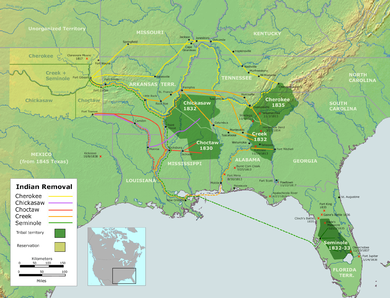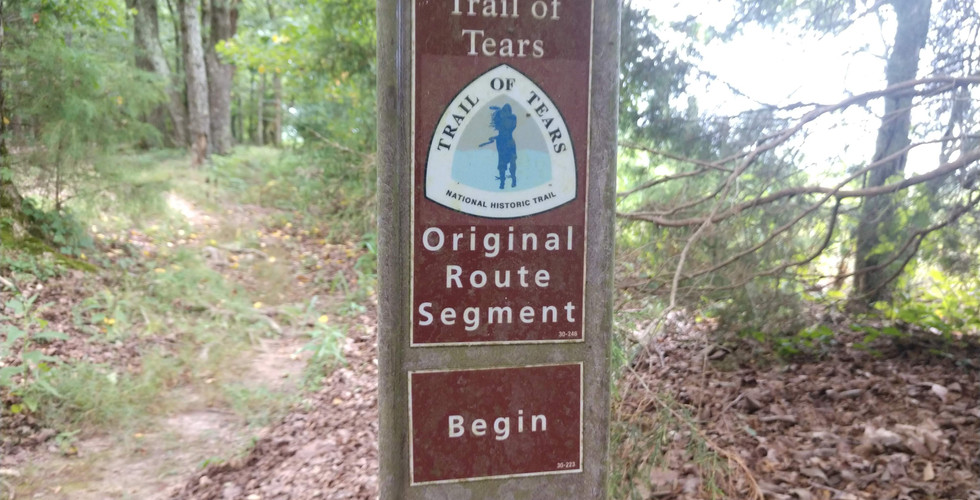
I'm going to step away from the battlefield for this week and explore one of the sadder parts of U.S. History.
Almost from the beginning, the U.S. experienced tremendous expansion. The new country was growing quickly and people were looking to leave the cities and grab a piece of land for their own. And farms were needed to feed the growing nation.
The original states were filling up, but there was still an abundance of land not settled by Europeans in the original states. There was a problem with that. Indians held claim to vast tracts of land.

At the beginning, the plan was to "civilize" the Natives, converting them to Chrisitanity and encouraging commerce and to purchase land from the tribes. While some progress was made, the process was met with resistance from both the Indians and settlers. The Indians wanted to keep their culture and live the life they were used to and Europeans looked upon them as "savages" who did not deserve to be treated as equals (although many didn't care one way or the other, they just wanted the land.)
In the Northeast, the prevailing attitudes led to conflict and the almost total extinction of the Native people. By the early 19th century many people felt that the only way to both obtain the land needed for expansion and also protect the Indian was to remove them from the disputed area and concentrate them on land outside the settled U.S.
This led to the Indian Removal Act of 1830. In essence, the Act gave the President the authority to negotiate terms for the relocation of the Indians in the Southeast U.S. to what is today Oklahoma and points west. The intent of the Act was to allow for compensation and a peaceful move for the Indians. That turned out not to be the case.

A small minority of Indians were willing to go along with the Act as intended, and in fact, a treaty was signed by the Choctaw in Mississippi, ceding their lands for new land and money. But most were against it. A small party of Cherokee signed a treaty in 1835, but the majority of the tribe resisted. President Jackson acted on his own, against Supreme Court instruction and ordered the forced removal of the Cherokee and others between 1830 and 1850.
Many of these relocations were brutal. In particular, the Cherokees in 1838. 16,000 members of the tribe were forced to march some 1000 miles across mountains, rivers and frozen land. Some 4,000 died along the way. In all over 15,000 Cherokee, Choctaw, Creek Seminole and Chickasaw souls were lost during the relocations. The name Trail of Tears was given to this tragedy.
Today, you can follow the Trail of Tears. In 1987, the federal government designated the Trail of Tears National Historic Trail. Over 2,200 miles of trails, roads and waterway passages are marked. And several Trail of Tears monuments are along the way. In Pulaski, Tennessee you can visit the Trail of Tears Interpretative Center. The Center was closed when I came through, but there are several outdoor exhibits, including a map of the section of Trails that went through the area. And in David Crockett State Park just south of Nashville there is a section of the original trail you can walk on.
And here's the side note: David Crockett was adamantly against the Indian Removal Act. He argued against it in the House of Representatives and was the only member of the Tennessee delegation to vote no. He lost his bid for reelection because of it.
And before you ask, this was not when he made his famous quote "You can all go to Hell and I will go to Texas" That happened when he ran again in 1835. He lost, and we all know the rest.
This is one that adventure I definitely suggest for everyone. And while you there, find a section of trail to walk. As you do, think of those people who suffered and died along the Trail of Tears. It's hard not to.
That's it for this week. I'm just finishing up on my tour of the Bourbon trail. Lots of new experiences there (and yes I remember them all!)
Next week is all travel. I'm headed to Gettysburg to visit the Battlefields there and in Antietam with a couple of quick stops along the way. I'm stretching my time there, so a day trip to D.C. (or two) is not entirely out of the question. I had wanted to spend more time in our Nation's Capitol, but so much stuff is closed that I think I'll wait until later for a more detailed excursion.
So, I guess it's more battles and history for now, so until next we meet...
Later, folks.









Comentários